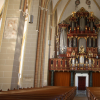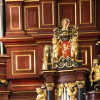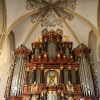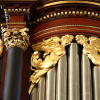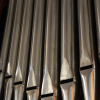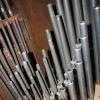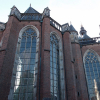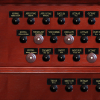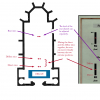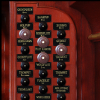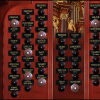Zutphen Virtual Organ Model
 The church of St. Walburga (Walburgiskerk) is a large gothic cathedral. The reverb time is enormous, ca. 8 seconds long. We spotted even up to 9 seconds on some tones. The church houses three pipe organs. The most important of them is the historical instrument of Hans Henrich Bader (died ca. 1680). The organ was constructed between 1637-1643 and it was placed on the northern side of the church at that time. First, Bader was commissioned to add a Rugwerk to an existing older organ, later he added a new Hoofdwerk and a Pedal. The independent Pedal was a distinctive and innovative feature of the Westphalian organbuilding tradition Bader represented, since Dutch organs of the first half of 17th century lacked the Pedal division.
The church of St. Walburga (Walburgiskerk) is a large gothic cathedral. The reverb time is enormous, ca. 8 seconds long. We spotted even up to 9 seconds on some tones. The church houses three pipe organs. The most important of them is the historical instrument of Hans Henrich Bader (died ca. 1680). The organ was constructed between 1637-1643 and it was placed on the northern side of the church at that time. First, Bader was commissioned to add a Rugwerk to an existing older organ, later he added a new Hoofdwerk and a Pedal. The independent Pedal was a distinctive and innovative feature of the Westphalian organbuilding tradition Bader represented, since Dutch organs of the first half of 17th century lacked the Pedal division.
Later, in 1813-1815, the organ was substantially rebuilt, enlarged and moved to the organ loft by J. W. Timpe. He added the third manual - the Bovenwerk. In 1906, the organ was moved again by G. Spit and J. C. Sanders to the western wall of the church. Also, the reeds were renewed at that time. The organ was damaged by fire in 1948.
A comprehensive restoration of the organ took place between 1993 and 1996 by Orgelmakerij Reil to the state of 1815 with some optimizations. The Bader concept is still clearly present in the Hoofdwerk, Rugwerk and the Pedal. New baroque-type reeds were supplied. The Bovenwerk was brought back to the shape of Timpe.
The wind is supplied by 5 wedge bellows, four of which date back to 1643. The organ is tuned in 1/6 comma meantone.
The organ belongs to the most notable organs of Netherlands and it is the finest surviving example of a Bader organ.
Special thanks to the Bader organ association for their warm welcome and assistance during our recording sessions.
Further reading: Some fine details and memories about the last restoration on the web page of John Boersma.
There are two variants of the sample set: the surround (6-channel) and the semi-dry.
Encryption
The samples are offered in 48kHz/24bit resolution. The multiple releases have three levels: short, mid and long. Hauptwerk v.7 and higher required. The surround variant of the sample set is encrypted, dongle protected. Hauptwerk Advanced version is strongly recommended, the Lite version is not suitable to run the Surround variant of the sample set (memory limitations, audio channels limitations). There is no use of the sample set possible in any other software. The semi-dry variant is distributed in a plain-wave format (no encryption). Therefore, the Semi-Dry variant can be used in Hauptwerk 4.2 and higher.
The reverb time is ca. 8 seconds.
Keyboards, pedalboard
The original compass of the keyboards is 54 keys. The original compass of the pedal division is 27 keys (extended to 30 keys).
Tremulants
All ranks were recorded with and without tremulants for the most convincing tremulant behavior. The third manual ranks were recorded with the general tremulant and also with the separate 3. manual tremulant (two different tremulant samples for each tone). However, loading tremmed ranks consumes large amount of RAM. It is possible to select to use the artificial tremulant instead to save RAM (the switch is located on the mixer tab).
Requirements
HDD space occupied 6-channel surround: 71 GB.
RAM consumption: 6-channel surround
-
16-bit, other settings default: 31.3 GB
-
20-bit, other settings default: 53.8 GB (recommended)
-
24-bit, other settings default: 60.3 GB
Suggestion for computers with 32 GB RAM: load all ranks, but truncate releases of the direct ranks (only of the direct ranks) resulting in 25.8 GB.
HDD space occupied 2-channel semi-dry: 34 GB.
RAM consumption: 2-channel semi-dry
-
16-bit, other settings default: 11.3 GB
-
20-bit, other settings default: 18.7 GB
-
24-bit, other settings default: 21.3 GB
Screen resolution 1280x1024 px or more.
Polyphony of 7000 voices recommended for the full suround (3500 pipes minimum).
Polyphony of 2500 simultaneous pipes recommended for use of the wet sample set.
Semi-dry format
The sample set is offered in a semi-dry variant (sometimes referred to as a "moist" sample set). The mics were located near the organ case, capturing thus a high portion of the direct pipe sound as originating from the organ case. However, the recording is not entirely dry since the microphone placement necessarily resulted in capturing a small portion of the reverberation of the church as well. The level of the reverb is low. The release tails can be cut in the Hauptwerk software to obtain reasonably dry audio.
Surround format
The sample set is offered in a surround variant (6 channels). In addition to the usual 4-channel surround, there are two more alternative front channels. In total, there are 4 front audio channels and 2 rear channels. The two pairs of the front ranks feature two different recording positions: direct (near to the pipes) and diffuse (distant from the instrument). These two pairs of the front ranks can either be mixed together freely to achieve any listening position between the two extremes, or used separately - depending on the prefererences of the user. A dedicated "mixing desk" is available in Hauptwerk to mix the sound to the desired level.
|
|
|
|
|||||||||||||||||||||||||||||||||||||||||||||||||||||||||||||||||||||||||||||||||||||||||||||||||
- Normal: II/I, III/II, I/II, I-P, II-P, III-P.
Accessories:
- Afsluiting for each manual, Tremulant for the whole instrument, separate Tremulant for the 3. manual.
The Organ
The Church
The Screenshots
The Screenshots explained
 |
Console view:this is the general console view. It serves to define the keyboard MIDI inputs for all the divisions. The only active part of this view are the manuals and the pedal. Specifying the MIDI inputs is done by right-clicking on the desired manual or pedal. All the other screen components are image-only. The left bottom shows the blower switch.
|
|
 |
Mixer view:The virtual listening position is adjusted here. Dragging the sliders downwards means to come closer to pipes (more direct sound), dragging them up means going away from the organ into the church nave. The mixer settings can be stored, retrieved, reset. 3 different mixer settings can be stored/recalled any time. The switch in the right makes the selection for the tremulant between the sampled tremulant and artificial (Hauptwerk model) tremulant. Useful for RAM saving.
|
|
 |
Left+Right Jambs view:for dual touch screens, split jambs were created. They allow for portrait or landscape orientation, according to the orientation of the touch screens.
|
 |
|
|
Left + Right Jambs Vertical view:the dual stop jambs offer vertical (portrait) orientation as an alternative. |
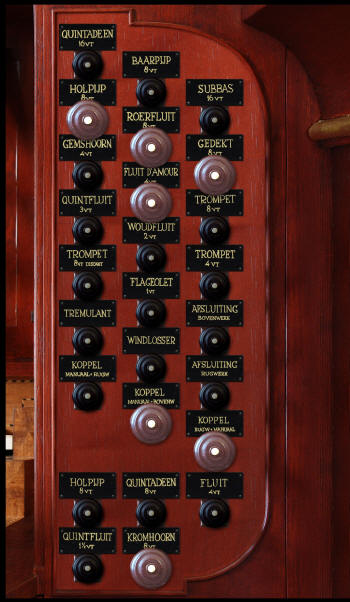 |
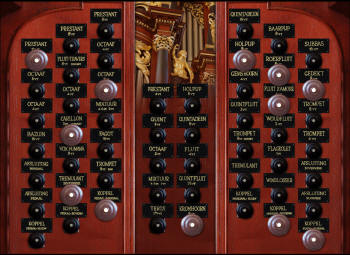 |
Single Jamb:for a single touch screen, this is the stop jamb to be used. All the stops of the organ can be found there. This view allows for landscape and wide landscape orientantion, according to the size of the touchscreen used. The attaching of the physical piston to a button on screen is done by right-clicking on the button. You may attach more than one MIDI physical switch to any of the drawstops on the screen. Note to the right click: The Single jamb, the Split Jambs and the Simple jamb, all allow for right-click to attach a specific MIDI hardware button to any of the software switch. This is done so that several different MIDI hardware buttons can operate one single software switch, so that the user can operate one stop or one and the same coupler with more than one hardware pistons.
|
|
 |
Single Jamb - wide screen variant. | |
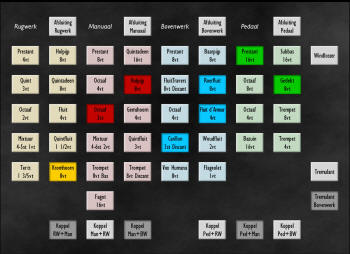 |
Simple Jamb:simplified version of a single jamb to allow for more readable version of the stop names on small LCD touch screens. |
|
Updates
Version 1.36 of the Surround set can be downloaded from within the "My Products" inside the user area. The sample set is good for Hauptwerk 7 (or higher).
Version 1.35 of the Semi-Dry set can be downloaded from within the "My Products" inside the user area. The sample set works in Hauptwerk 4.2 and higher.
-
Zutphen Surround Software Sample Set
Zutphen - Surround. Encrypted, dongle protected. Minimum Hauptwerk version: 7. (Also works in all higher versions.) -
Zutphen Semi-Dry Software Sample Set
Zutphen Baderorgel Model - semi-dry, plain wave format. Minimum Hauptwerk version: 4.2. (Also works in all higher versions.)

